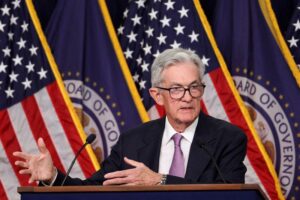As we look ahead to the U.S. and global markets, investors are reacting positively to the Federal Reserve’s recent decision. Fed chairman Jerome Powell’s description of the interest rate cut as a “recalibration” rather than an emergency measure has soothed nerves and provided reassurance that the central bank is focused on achieving a soft landing for the economy.
The markets reacted with optimism, with stock futures surging to new records and Treasury yields remaining steady. The dollar initially dropped but has since stabilized, and other major currencies like the yen and sterling are also seeing movements in response to central bank decisions.
Powell’s emphasis on the job market and the Fed’s projections for further rate cuts have set the stage for additional easing measures in the near future. While the Fed has indicated a total of 50 basis points in cuts for the rest of the year, market expectations are pricing in even more aggressive actions.
Analysts are predicting that the Fed may be pushed into deeper cuts in response to potential weaknesses in the labor market. With the focus shifting to job data, upcoming economic indicators like weekly jobless claims will be closely watched for signs of any shifts in the economy.
On a positive note, the housing market is showing signs of rebounding, with lower mortgage rates fueling a surge in housing starts. This should provide support for the economy as it continues to expand.
Historically, stock markets have performed well during periods when the Fed cuts rates during an economic expansion. On average, stocks have gained more than 16% following rate cuts, with both large and small-cap growth stocks leading the way.
As U.S. futures point to a strong start on Thursday, global markets are also rallying. Asian markets have shown gains, reflecting positive sentiment around central bank actions. European markets are also on the rise, although some countries like Norway have opted to keep rates unchanged.
Looking ahead, key events and data releases will provide further direction for U.S. markets. The Bank of England’s policy decision, U.S. jobless claims, housing sales data, and corporate earnings reports will all be closely watched for insights into the economic landscape.
In summary, the recent actions by central banks and the Fed’s stance on future rate cuts have provided a sense of stability and direction for investors. As we navigate through the market uncertainties, staying informed and understanding the implications of these decisions will be crucial for making informed investment decisions. Stay tuned to Extreme Investor Network for more updates and analysis on how these developments may impact your investment strategy.

